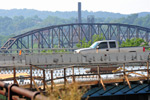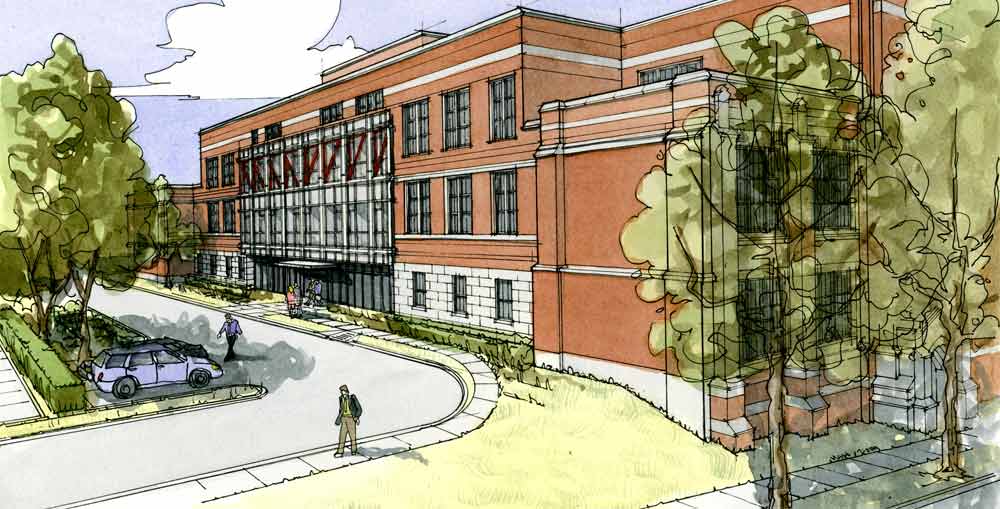
Category Archive: Landscapes
-
Movie Money Spurs Vandergrift Spending Ideas
By Rossilynne Skena and Dale Mann, VALLEY NEWS DISPATCH
Monday, July 19, 2010The borough received $15,000 for opening its streets in June to crews filming “I am Number IV,” an action-packed thriller.
Of the money received from DreamWorks, $5,400 has be allocated to parking meters. There are about 250 parking meters on the borough streets, and those meters need constant updates, council president Brian Carricato said.
The average parking meter costs about $110. Fifty new meters will be purchased and will go into circulation where meters are broken or missing.
Council will vote at its August meeting about how to spend the remaining $9,600.
Carricato would like to see the full sum of the money remaining go toward the recreation committee.
DreamWorks wants to see the money applied to something such as recreation, something the town can look back on in 10 years as an accomplishment, Carricato said.
Typically, he said, recreation is an area where budgets can be cut because other things are more essential.
“There’s not too many times that you do have the opportunity to invest back into your recreation department,” Carricato said.
Christine Wilson, a council member who serves as chairwoman of the budget committee, proposed another plan.
She too would like to see the $5,400 go toward meters, and then allocate $6,500 to codify the borough’s ordinances, which haven’t been updated since 1998. The remaining $3,100 would go to recreation.
Carricato said there’s money in the general fund to use for codifying ordinances.
“We have $42,000 from gas wells in the general fund that should be used for codifying the ordinances,” Carricato said, adding that two more gas wells, located near the Vandergrift Cemetery, will be starting up in the next few weeks.
Wilson said that $20,000 is put into the bank up front for each gas well, and that money is supposed to be used for emergencies.
“I don’t like dipping into that money that we’re putting into the bank for emergency-use only,” Wilson said.
The three operational gas wells brought in more than $25,519.30 for the borough between January and June 30, Borough Secretary Steve DelleDonne said. Wells are located behind the municipal garage, on the Ninth Street Alley above East Vandergrift and on hillside dropping into East Vandergrift, Carricato said.
Wilson disagreed with using any of the gas well funds. Carricato said the money from the gas wells is budgeted into the general fund as anticipated revenue.
Discussion of what to do next was tabled until the next meeting, Wilson said, at which point the recreation committee will bring proposals of how to use the funding.
Carricato and two others recreation committee will meet to discuss ideas, but as for what ideas they have, residents will be in suspense until council meets.
“We’ve already been brainstorming,” Carricato said.
-
Old School Steps to Front of the Class
By Eric Heyl
PITTSBURGH TRIBUNE-REVIEW
Wednesday, July 21, 2010Consider it a textbook example of how to transform a dilapidated eyesore into a potential community jewel.
For nearly a quarter-century, the former South Hills High School in Mt. Washington slowly deteriorated while various redevelopment proposals were about as successful as the initial Hindenburg launch.
As recently as 18 months ago, the enormous 155,000-square foot building occupying an entire city block at the corner of Ruth and Eureka streets stood empty and decaying.
Surrounded by an imposing chain link fence, the old school appeared as though it never would be anything more than a refuge for birds seeking shelter through the holes in the roof.
Since then, the scene has changed dramatically.
“We’ve come a long way,” Victor Rodriguez said Tuesday, standing in the vicinity of where the principal’s office used to be. “I think this is pretty monumental in terms of what we’ve accomplished.”
Rodriguez is senior vice president of a.m. Rodriguez Associates, which purchased the building from the city’s Urban Redevelopment Authority two years ago for $1. Given the structure’s condition at the time, Rodriguez might have overpaid for it.
But following a $23 million makeover that included $10 million in public money, the structure will reopen in about six weeks as the South Hills Retirement Residence.
The place is proving popular among the senior crowd even before the first tenants move in. As contractors scurry to apply the finishing touches, 42 of the building’s 106 units have been leased.
Rodriguez yesterday provided me a tour of the building, the inside of which looks virtually nothing like it did when the Class of ’86 closed the school for good.
Although some of the original hardwood and ornate metal railings were incorporated into the interior design, it’s unlikely the 2,200 members of the school’s alumni association would recognize the place.
That’s a good thing.
Rodriguez removed several unsalvageable portions of the former school, including the auditorium and the swimming pool, while adding amenities the 94-year-old building desperately needed — elevators and air conditioning.
In addition, a portion of the building is expected to house medical offices, which should further increase foot traffic in what had become a desolate neighborhood. An early childhood development center also might occupy some space.
“What we’re striving for here is something community-changing,” Rodriguez said.
Joshua “J.T.” Smith, board president of the Mt. Washington Community Development Corp., lives about two blocks away and is thrilled with how the place looks.
“For years, that building created a real negative mood with all of that prison-style fencing around it,” he said. “It’s great to walk by now and see something vibrant and alive, with the new trees and the clean sidewalks. This is going to alter the mentality of the whole neighborhood.”
Again, it’s a textbook example of transformation.
For an old school, what could be more appropriate?
-
Artists on Board for Mural Project Behind Tarentum Station Restaurant
By Tom Yerace
VALLEY NEWS DISPATCH
Tuesday, July 20, 2010
Last updated: 7:41 amThe mural project for the wall behind the Tarentum Station restaurant is picking up steam, according to borough officials.
Borough Manager Bill Rossey said he has been contacted by five local artists who want to volunteer their services for the project.
Councilman Ray Kerr, who is coordinating the project with Rossey, said more artists are needed on a volunteer basis since the borough wasn’t able to secure a grant to pay for the project.
He said paint for the mural is being donated by two borough paint stores: Van Sciver’s Wall Covering and Paint and Verner’s Paint Center.
“Right now we are moving pretty good on it,” Kerr said.
Rossey said a primer was applied to the wall over the weekend.
It’s ready for the mural, which will be 175 feet long and range from 6 feet to 4 feet high.
Kerr and Rossey said the mural will have a historical theme, using the image of a train, but with the cars of the train depicting historical people and events related to the borough.
“What we need now are people (subjects) from Tarentum,” Kerr said. “We need faces if anybody can come up with some pictures, they would be welcomed.”
Kerr said the project should be completed before the end of summer.
“It will certainly be a point of interest for people coming through town to pass by and look at that wall, ” Rossey said.
In other business:
• Council approved applying for a federal Community Development Block Grant for Streetscape improvements to the business district.
The application will be for $105,000 to do the actual improvements, such as new sidewalks and lighting, according to Rossey. He said that will supplement a $60,000 grant the borough received this year to pay for planning of the improvements.
Rossey said the borough will be putting out a request for proposals on designs soon.
In addition to the $60,000, the borough also has set aside $15,000 from its budget for planning costs, Rossey said.
He also said that it also is reserving $45,000 to use for the improvements and could use money left over from the $75,000 reserved for planning to pay for the actual work.
He said borough officials believe they can do at least one block of E. Sixth Avenue and try to do subsequent blocks every year.
• Council has granted permission for the Alle-Kiski Historical Society to hold a Civil War encampment in Riverview Park. The encampment by re-enactors will be Aug. 21 and 22.
-
$17.5 Million for Steel Heritage Sought
dBy Matthew Santoni, PITTSBURGH TRIBUNE-REVIEW
Saturday, July 17, 2010
National heritage park promoters want a ramp built at the Rankin Bridge to provide better access to the former Carrie Furnace (background). Sidney Davis | Tribune-Review
Allegheny County officials are hoping the federal government will invest $17.5 million in a project to turn a former steelmaking site into a national heritage park and build a ramp at the Rankin Bridge to lead visitors to it.
The county, city of Pittsburgh, Port Authority and Port of Pittsburgh Commission are among agencies seeking a share of $600 million in transportation grants that would fund projects to reduce congestion, promote economic activity or improve livability.
At Carrie Furnace, the county wants to build a “flyover” ramp from the interchange at the foot of the Rankin Bridge to carry traffic above four railroad tracks that isolated the former steel mill.
“The (current) access is good for emergency vehicles and some other traffic, but it’s over two sets of active railroad tracks, and you’d have to wind your way back there on a couple of little, local streets,” said Bob Hurley, deputy director of the county’s Department of Economic Development.
The county wants to redevelop 148 acres that once housed the blast furnaces along the Monongahela River in Rankin, part of the former U.S. Steel Homestead Works. The project would include homes, offices and light industry, along with a park commemorating the Mon Valley’s industrial heritage, Hurley said.
The Homestead-based Rivers of Steel National Heritage Area, which took over the furnaces, wants to offer public tours of the site to drum up support for a museum, said Sherris Moreira, director of marketing and tourism development. Built in 1907 of steel plate and brick, the Carrie Furnaces No. 6 and 7 tower 92 feet above the river as examples of pre-World War II iron-making technology. They are the only non-operative blast furnaces remaining in Pittsburgh. In the 1950s and ’60s, they produced up to 1,250 tons of iron a day.
The county tried to get stimulus money for the project and did not; that application asked for $60 million and included a plan to convert an old bridge over the Mon for cars and pedestrians going to Route 837 and The Waterfront. Officials will still try to get money for the bridge, Hurley said.
The $600 million in transportation grants will be awarded in fall. Others seeking money:
• Port of Pittsburgh Commission, as a government partner for river industries. Cecil-based Consol Energy Inc. wants $44 million to add a coal storage area to its Alicia Docks near Brownsville, and Three Rivers Marine and Rail Terminal near Charleroi wants $1.5 million to upgrade railroad connections. The companies would invest matching money.
• The Port Authority of Allegheny County might reapply for money to start its “Better Bus” or “Rapid Bus” initiative, said spokesman Jim Ritchie. The authority plans to convert nine routes to “rapid bus” service that would have fewer stops, use ticket machines at bus stops instead of fare boxes on buses and get priority at traffic signals in order to make faster trips to Pittsburgh International Airport, Downtown, Oakland, the East End and the Mon Valley.
-
Rodef Shalom’s Garden Grows into Latest Exhibit of Wearable Greens
By Alaina Raftis , TRIBUNE-REVIEW
Thursday, July 15, 2010
The heavily cultivated and well-maintained garden -- which sits on a third of an acre off of Fifth Avenue in Oakland -- was created by Irene Jacob, a botanist who founded the docent program at Phipps Conservatory and Botanical Gardens, and her husband, Rabbi Walter Jacob, to bring people closer to the Bible in a nontraditional way. Justin Merriman | Tribune-Review
The lush greenery at Rodef Shalom’s Biblical Botanical Garden is celebrating it’s 25th year with a new exhibit titled “What Shall I Wear?”
This year, the garden showcases various plants and flowers that have been used to make clothing and fragrances for thousands of years.
The heavily cultivated and well-maintained garden — which sits on a third of an acre off of Fifth Avenue in Oakland — was created by Irene Jacob, a botanist who founded the docent program at Phipps Conservatory and Botanical Gardens, and her husband, Rabbi Walter Jacob, to bring people closer to the Bible in a nontraditional way.
Often referred to as “Little Israel” because its geography replicates the confines of the Holy Land, the garden features various miniature landmarks such as Mt. Hermon, a mound of stones stacked beneath the shade of the billowing Acacia trees, and the Jordan River, a tranquil stream of water trickling from one corner of the garden to another.
The thousands of signatures penned in the guest book each season are only one sign of the garden’s success.

Often referred to as "Little Israel" because its geography replicates the confines of the Holy Land, the garden features various miniature landmarks such as Mt. Hermon, a mound of stones stacked beneath the shade of the billowing Acacia trees, and the Jordan River, a tranquil stream of water trickling from one corner of the garden to another. Justin Merriman | Tribune-Review
“This is the largest and most complete garden of its kind,” says Arlyn Gilboa, who has been a docent at the garden for 15 years, “It’s wholly dedicated.”
The garden contains 56 out of 110 plants specifically mentioned in the Bible and an additional 50 flowers that Jacob added to awaken the verdant oasis.
“Some people come to Pittsburgh just to see the garden,” says Jean Simon, another docent.
Plants that aren’t mentioned in the Bible were given creative names such as, “Jacob’s Coat,” “Angel’s Tears” and “Elijah’s Blue” to play along with the biblical theme.
This year’s exhibit “was just something new that we haven’t focused on before,” Gilboa says. “Sometimes our exhibits don’t have biblical roots, but this year it certainly does.”

The garden contains 56 out of 110 plants specifically mentioned in the Bible plus more. Justin Merriman | Tribune-Review
Some of the plants featured in this year’s exhibit are used for the essential oils in perfumes and fragrances. They include, among others, banana shrubs, carnations, chamomile, gardenia, geranium, jasmine, kumquat, lemon verbena, mock orange, musk plant, myrtle, patchouli, rose, rosemary and sage. The cotton and flax plants also are displayed and both have been used to make clothing since the ancient times.
“It’s a wonderful thing,” Gilboa looks at the two massive Cedar of Lebanon trees at the entrance to the garden. “The fact is that the ancients were dependent on plants, and so are we. For me, I feel a strong connection with Jewish history when I’m here. It’s such a treat.”
Rodef Shalom Biblical Botanical GardenWhen: Through Sept. 15. Hours: 10 a.m.-2 p.m. Sundays-Thursdays; 7-9 p.m. Wednesdays; noon-1 p.m. Saturdays Guided tours available 12:15-1 p.m. Aug. 6 and Sept. 3
Admission: Free
Where: Rodef Shalom Temple, 4905 Fifth Ave., Oakland
Details: 412-621-6566
-
McKeesport Will Demolish 15 Homes
Thursday, July 15, 2010By Candy WoodallMcKeesport’s 7th Ward is getting a face-lift.
Despite a poor economy, McKeesport continues to attract stimulus dollars to improve its neighborhoods.
Using a $100,00 from Allegheny County, Mayor James Brewster said the city will raze another 15 blighted homes along Bailey Avenue, beginning on July 27.
“We’re tearing down a house every four days,” he said.
Mr. Brewster has worked to remove half of McKeesport’s 600 blighted properties since he took office seven years ago, calling them fire and public safety hazards.
Old, boarded-up houses aren’t the only things coming down in the 7th Ward.
Cornell Intermediate School is being demolished to make way for the new Cornell Elementary/Intermediate School being built on the same property as part of McKeesport Area School District’s $46.4 million plan to build two new schools and renovate a third.
The Cornell construction will cost $29 million and help revitalize the neighborhood, according to Superintendent Michael Brinkos.
It is being developed as a green building that will accommodate kindergarten through sixth grade, featuring state-of-the-art facilities and technology, he said.
A public hearing was held Monday in the district’s board room regarding the school’s construction plans.
In addition to removing blight and replacing a 94-year-old school with a new one, City Council also unanimously approved an agreement with McKeesport Neighborhood Initiative to begin $1.4 million of housing development in the Seventh Ward.
“That will complement the new Cornell school,” Mr. Brewster said.
A Weed & Seed initiative will offer help in the 7th Ward, which is a target area along with the 2nd, 3rd and 5th wards.
As a local branch snags funds from Pennsylvania’s recently passed budget, it will work to fulfill the goals of Weed & Seed, a national program that seeks to improve conditions in high-crime neighborhoods.
The city’s Weed & Seed will have $75,000 from the state and $8,330 from the city for an $83,330 budget for the coming year, said Dennis Pittman, city administrator.
The money is earmarked for prevention and intervention programs and pairs with law enforcement efforts.
-
Latrobe Considers Trails Linking to Saint Vincent
Thursday, July 15, 2010By Candy WoodallLatrobe foundation and city leaders are deciding how to establish a trail system that would link the region’s educational, recreational and industrial institutions.
The first step is creating a 2-mile trail from Saint Vincent College in Unity to neighboring Latrobe to provide a connection for the campus’ 2,000 students to the city’s business district.
It’s part of an effort to revitalize the community, according to Ron Weimer, who wears two hats as chairman of the Latrobe Community Revitalization Program and chairman of the Latrobe Planning Commission.
Reaching out to the college has been a goal of the revitalization program for a long time, he said.
Drafts for the trail include utilizing two of the college’s greatest assets — and Westmoreland County’s most famous names — and connecting them to the city’s biggest park.
The school’s Fred M. Rogers Center and Winnie Palmer Nature Reserve would tie in to the proposed trail, and patrons would be able to walk, jog or bike to the 52-acre Legion Keener Park in the heart of Latrobe’s business district. Those on foot or bicycle could then connect to the park trails there.
And those trails may be extending as well. Plans are in the works throughout Latrobe and Derry Township to lay down a trail system that would run along Loyalhanna Creek up to Keystone State Park and the Loyalhanna Gorge.
Early funding — which paid for the Saint Vincent to Latrobe viability study — was provided by the Port of Pittsburgh Commission and the McFeely-Rogers Foundation. The commission awarded a $16,000 grant and the foundation provided $4,000 to finance the $20,000 study conducted by Pittsburgh-based Pashek Associates.
Jim Pashek, president of Pashek, said his firm’s job was to find a feasible way to get from the college to downtown, and that was fraught with some challenges.
The plan features options of how to have the $2.2 million trail — which would largely be funded by foundation grants and private money — bypass the busy Route 981.
One option calls for building a bicycle bridge, and another would use streets parallel to the highway to form the crushed-stone trail, which is designed for traffic by feet, bicycles, strollers and wheelchairs, but not skateboards.
With volunteer work and in-kind services, Mr. Pashek said project costs could be reduced by $482,000. And if the trail parallels the highway, the costs could be reduced by $700,000.
Latrobe’s foundation and commission leaders will have to decide which path the trail should take and will then secure private funding to construct it, Mr. Weimer said.
Mr. Pashek’s firm has worked on dozens of trail projects throughout the region, and he said the popularity is growing.
Mr. Weimer said there’s no question trails are popular in Latrobe.
“All you see are cars around here with racks to haul bikes,” he said.
That popularity inspired the McFeely-Rogers Foundation to support the trail project as it has always had a vested interested in parks and recreation, according to James R. Okonak, executive director at that organization and vice president of the Latrobe Foundation.
“We feel recreation enhances the quality of life,” he said.
“Because of the state of the economy, people can’t always afford to go to the beach for a week or two anymore, so they sort of hunker down and rely on local activities,” he said.
Municipalities are also struggling through the poor financial climate, and the new trail will offer another way to attract a young demographic to Latrobe.
Students will have a choice of restaurants and businesses to go to, as well as a “fantastic arts center,” Mr. Okonak said.
“Anything that helps to connect us with the community of Latrobe to make the city more accessible to our students is all very positive,” said Don Orlando, the college’s spokesman.
Mr. Okonak said he can’t ignore all the Steelers traffic during training camp.
“Maybe the connection would be that fans would come to practice and then bike into the city center,” he said.
His sights are set on even bigger things. He said he sees an opportunity with an abandoned Norfolk Southern rail line parallel to Lincoln Avenue.
That slice of the city can be developed into a dog park and walking/jogging area, he said. City leaders have engaged in talks with the rail company to take over the property.
“And there’s also a thought of taking the trail parallel to the Loyalhanna Creek through Derry to connect to Keystone [State Park] and up to the Loyalhanna Dam,” he said.
Not only are trails a hot topic in Latrobe, they’re gaining popularity all over the state. The Pennsylvania Department of Conservation and Natural Resources has given out “multiple millions of dollars” in grant money to fund trail work, said Chris Novak, press secretary.
The state’s 281 trails span nearly 7,000 miles and provide “a good, family activity that’s not expensive,” she said.
With high gas prices, it’s also being looked at as an alternative to getting around, she said.
It’s also looked at as a way to bring in visitors to an area to spend money.
Several businesses, ranging from ice cream parlors to produce stands to bike shops, are popping up along trails and can be a large part of what spurs the economic benefit, said Mike Kuzemchak, program director at the Ligonier branch of the Western Pennsylvania Conservancy.
Multi-use trails are extremely popular throughout the Laurel Highlands and attract a diversity of people, he said.
That diversity of traffic is good for the ecosystem and is what attracted the Port of Pittsburgh to provide a grant for the Saint Vincent to Latrobe project.
Jim McCarville, executive director of the Port of Pittsburgh, said his organization has a small grant program that awards between $5,000 and $20,000 to make improvements along streams and waterways in the region.
That the Saint Vincent/Latrobe project may spur growth along the Loyalhanna Creek and beyond is very inviting to Mr. McCarville.
The surge in interest in trails, many of which locally are along rivers and streams, proves that people want to reconnect with waterways and see them as an attractive resource.
“Each trail has its own charm and beauty, and linking the college with the downtown area will create a very attractive place for recreation,” he said.
-
Group Asks 1-Year Delay in Mellon Arena Demolition
Thursday, July 15, 2010By Mark Belko, Pittsburgh Post-GazetteA group seeking to save Mellon Arena today urged its owner to delay a proposed demolition for one year.
Rob Pfaffmann, a Downtown architect who leads Reuse the Igloo, asked the city-Allegheny County Sports & Exhibition Authority board to give the group a year to develop an economically viable plan to save the Igloo. The SEA owns the building.
“We do not want to see a white elephant,” he said.
Mr. Pfaffmann said the group also would develop a plan to help the SEA cover the operating costs of the building while a more thorough planning process is undertaken and alternatives are studied.
“We should not rush to judgment on this if we have an economic circumstance that doesn’t demand it,” he said.
Mr. Pfaffmann was among about 10 people to speak at the SEA meeting today in favor of saving the building.
“There’s no do over. Once it’s gone, it’s gone and it will never be back again,” said Nancy Motz Cosnotti. “If the Civic Arena is gone, then part of Pittsburgh will be gone and I don’t want that.”
Reuse the Igloo also would like to see the SEA open the arena’s distinctive dome as a demonstration to see if it still works and to determine the cost of operating it.
SEA Executive Director Mary Conturo said no vote has been scheduled yet on a demolition, favored by the Penguins, Mayor Luke Ravenstahl and county Executive Dan Onorato.
She said the SEA is still in the process of reviewing options through an ongoing historic review process.
Asked whether the SEA would agree to a one-year delay, board chairman Wayne Fontana said the request would be taken under advisement.
“I’m not adverse to anything at this point,” he said.

